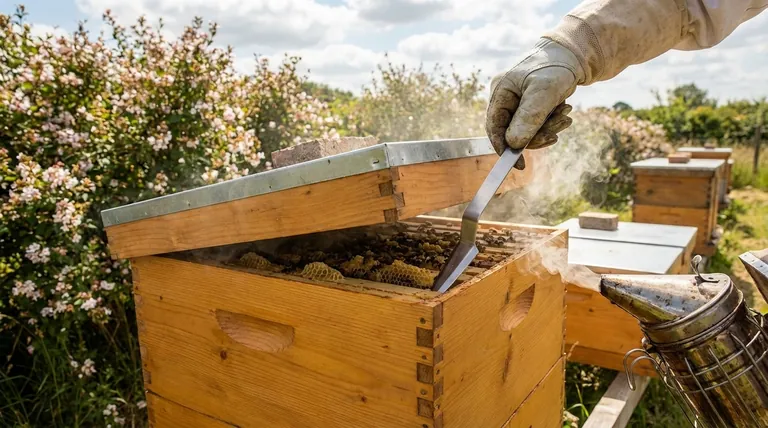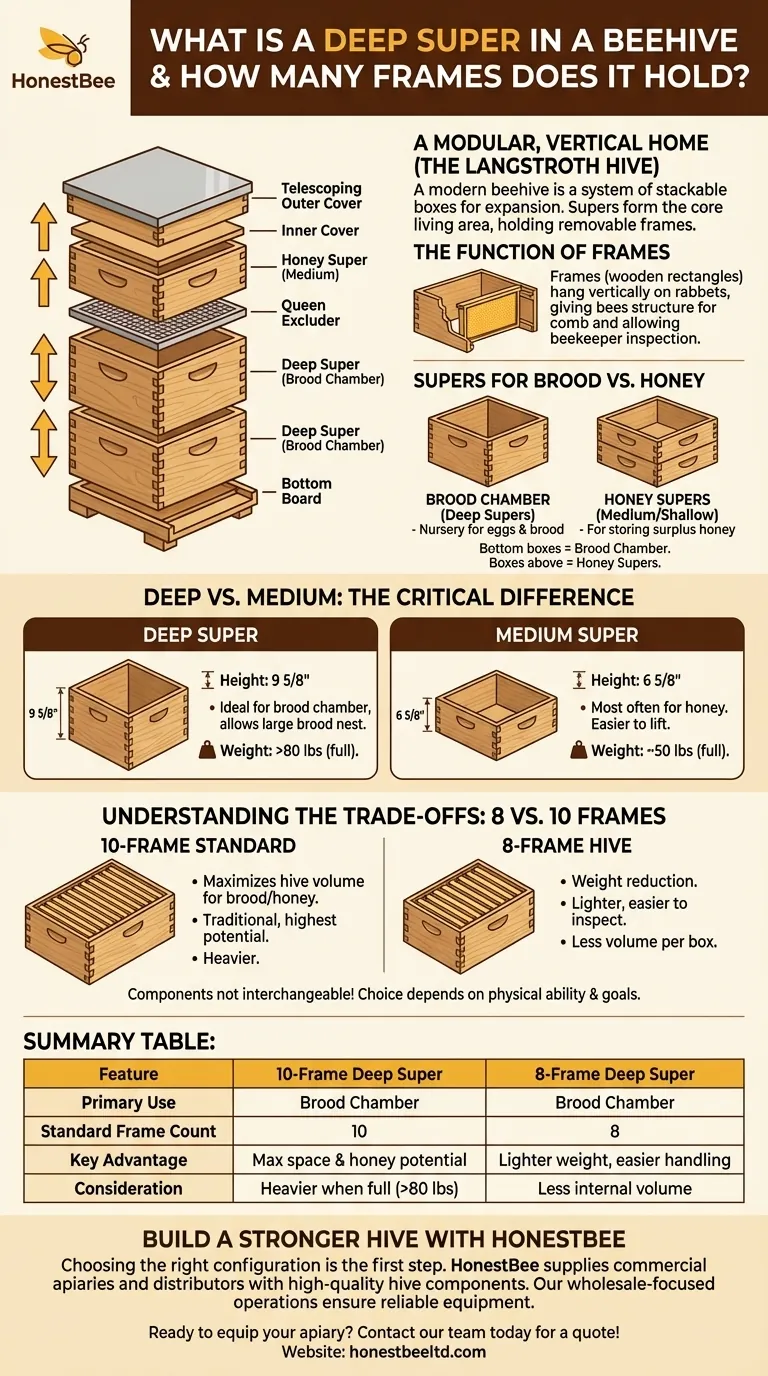In beekeeping, a deep super is one of the standard-sized boxes used to construct a modern beehive, specifically the largest or "deepest" size available. It typically holds either 8 or 10 frames, which provide the structure for the bees to build their wax comb. These deep supers are most commonly used to house the colony's brood chamber—the nursery where the queen lays her eggs.
A deep super is not just a box; it is the foundational living space and nursery for the bee colony. The choice between using 8 or 10 frames within that box is a critical decision that balances the colony's internal space against the physical weight the beekeeper must manage.

The Role of the Hive Body (Super)
A Modular, Vertical Home
A modern beehive, known as a Langstroth hive, is a system of modular, stackable boxes. This allows the beekeeper to expand or shrink the hive's size based on the colony's needs.
A complete hive consists of a bottom board, one or more supers (boxes) that form the core living area, an inner cover, and a telescoping outer cover for weather protection.
The Function of Frames
Each super is designed to hold a set of removable frames. These wooden rectangles consist of a top bar, two side bars, and a bottom bar.
The top bar has extended ends that rest on a ledge inside the super, called a rabbet, allowing the frames to hang vertically with precise spacing. This design gives bees a structure to build their wax comb and allows the beekeeper to inspect the colony without destroying its work.
Supers for Brood vs. Honey
The term super simply refers to any of the boxes stacked above the bottom board. However, their function differs based on their position.
The bottom one or two boxes are typically designated as the brood chamber. This is where the queen lays eggs and the young "brood" are raised. The boxes stacked on top of the brood chamber are used by the bees for storing surplus honey and are called honey supers.
"Deep" vs. "Medium": The Critical Difference
Defining the "Deep" Super
In beekeeping, box sizes are standardized. A deep super has a height of 9 5/8 inches. This extra depth creates large, uninterrupted frames.
This significant vertical space is ideal for the queen's laying pattern, allowing her to establish a large and cohesive brood nest without being constrained by the frame's bottom edge. A common and robust setup for a brood chamber is to use two deep supers stacked on top of each other.
The "Medium" or "Honey" Super
In contrast, medium supers are shorter, typically 6 5/8 inches high. While they can be used for brood, they are most often used for honey collection.
Their smaller size means they are significantly lighter when filled with dense honey, making them much easier for the beekeeper to lift and harvest. A full deep super can weigh over 80 pounds, whereas a medium is closer to 50 pounds.
Understanding the Trade-offs: 8 vs. 10 Frames
The 10-Frame Standard
The original Langstroth hive was designed to hold 10 frames. This configuration maximizes the internal volume of the hive, providing the most space for brood rearing and honey storage within a single box.
This is the traditional standard and offers the highest potential for a large, productive colony.
The Rise of the 8-Frame Hive
In recent decades, the 8-frame hive has become a popular alternative. The boxes are narrower but use the same standard-depth frames (deep, medium, or shallow).
The primary advantage of the 8-frame system is weight reduction. With two fewer frames of brood, pollen, and honey, each box is lighter and easier for the beekeeper to lift and inspect, reducing physical strain.
What This Means for Your Hive
The choice between 8 and 10 frames is a fundamental one, as the components are not interchangeable. An 8-frame box will not fit on a 10-frame box.
While a 10-frame hive offers more space per box, bees thrive in both configurations. The decision ultimately rests on the beekeeper's physical ability and management style.
Making the Right Choice for Your Goal
When selecting equipment, the first decision is your hive's width—either 8-frame or 10-frame. Deep supers serve as the ideal brood chamber in either system.
- If your primary focus is maximizing colony space and honey potential: The traditional 10-frame hive provides the most volume per box, which can support a larger population.
- If your primary focus is ease of handling and reducing physical strain: The 8-frame hive is a lighter, more manageable alternative that makes hive inspections less demanding.
Understanding these foundational components empowers you to build a hive that works for both the bees and your own beekeeping practice.
Summary Table:
| Feature | 10-Frame Deep Super | 8-Frame Deep Super |
|---|---|---|
| Primary Use | Brood Chamber (Nursery) | Brood Chamber (Nursery) |
| Standard Frame Count | 10 | 8 |
| Key Advantage | Maximizes colony space & honey potential | Lighter weight, easier handling |
| Consideration | Heavier when full (80+ lbs) | Less internal volume per box |
Build a Stronger Hive with HONESTBEE
Choosing the right deep super and frame configuration is the first step to a successful apiary. At HONESTBEE, we supply commercial apiaries and beekeeping equipment distributors with the high-quality, durable hive components needed to build a thriving operation. Our wholesale-focused operations ensure you get the reliable equipment your business depends on.
Ready to equip your apiary for success? Contact our team today to discuss your needs and get a quote!
Visual Guide

Related Products
- HONESTBEE Professional Long Handled Hive Tool with Precision Cutting Blade
- Australian Langstroth Beehive Boxes for Beekeeping Wholesales
- Professional Insulated Plastic Bee Hives
- Langstroth Honey Bee Box Hive Boxes for Different Depths
- Portable Bee Mating Hive Boxes Mini Mating Nucs 8 Frames for Queen Rearing
People Also Ask
- How should beekeepers handle bees when using a hive tool? Master Calm, Deliberate Techniques
- What are the basic tools for beekeeping? Essential Starter Kit for Safe & Successful Hive Management
- What is a hive tool used for in beekeeping? Your Essential Guide to Hive Management
- What are the features of a regular hive tool? The Essential Multi-Tool for Every Beekeeper
- Why do hive tools have a hole? Unlock the Secret to Efficient Beekeeping



















